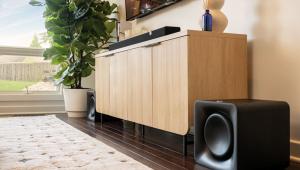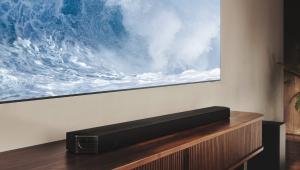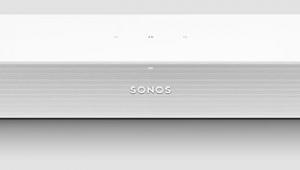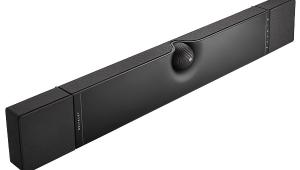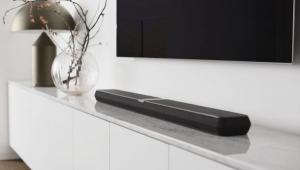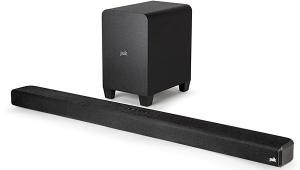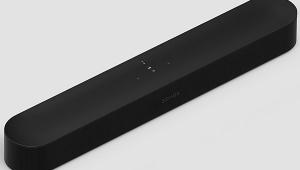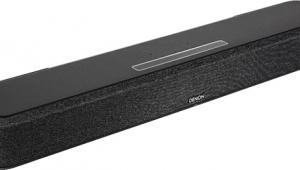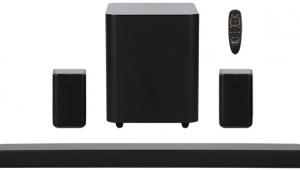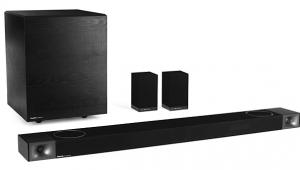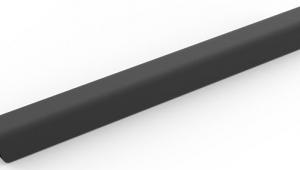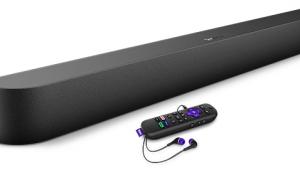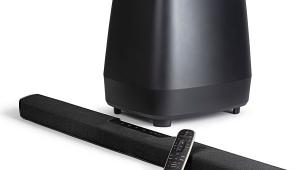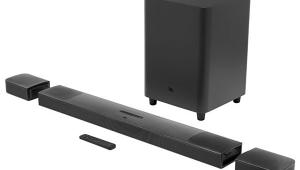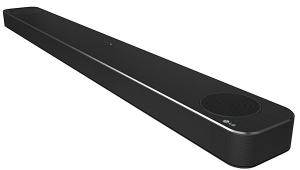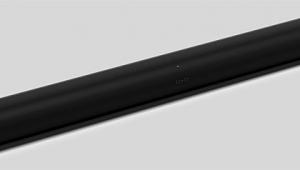Test Report: Atlantic Technology PowerBar 235 Soundbar Page 3
My A/V dealer buddies tell me that people are using soundbars for music listening in addition to movies and TV, so I switched the PowerBar 235 to 2-channel mode and spun my test CD and a few other discs. It sounded plenty good enough for casual listening. The guitars, vocals, and fiddle in Steve Earle’s “The Devil’s Right Hand” (from Copperhead Road) all sounded natural, but the ambience wasn’t there — the sound was very much confined to the bar. Even though the Atlantic Technology PowerBar 235 never sounded thin with movies, I found myself wanting a bit more bass with music.
Thus, at Atlantic Technology president Peter Tribeman’s urging, I tried adding Atlantic’s SB- 900, an 8-inch, 125-watt subwoofer that sells for $350. Objectively, the SB-900 just added bass, but subjectively it did much more. Suddenly, the PowerBar 235 sounded like a real home theater system. When I revisited that scene in The Punisher, I got a much more thrilling ride. The punches got punchier, the grenade explosion gave me a lot more shake, and the bar itself seemed to play a little louder and cleaner.
Extended Test Bench
Frequency response
48 Hz to 20 kHz ±5.4 dB (0° on-axis)
48 Hz to 20 kHz ±4.1 dB (average ±30° window)
Bass output (CEA-2010A standard)
• Ultra-low bass (20-31.5 Hz) average: NA
20 Hz: NA
25 Hz: NA
31.5 Hz: 76.7 dB
• Low bass (40-63 Hz) average: 105.9 dB
40 Hz: 97.1 dB
50 Hz: 106.8 dB
63 Hz: 109.6 dB
I measured the PowerBar 235 with the microphone placed at a distance of 2 meters, using quasi-anechoic technique to remove the effects of reflections from nearby objects. I measured it on a 2-meter-high stand, measuring the left channel only with the unit in two-channel mode to eliminate all surround processing. I adjusted the microphone position for the flattest on-axis response and then averaged the measurements at 0°, ±10°, ±20°, and ±30°, smoothed to 1/12th octave. Bass response was measured using ground plane technique with the microphone on the ground 2 meters from the speaker; this was smoothed to 1/3rd octave and then spliced to the quasi-anechoic measurements at 200 Hz. Results are normalized to 0 dB at 1 kHz. All frequency response measurements were made with a Clio FW audio analyzer and then imported into a LinearX LMS analyzer for post-processing.
The PowerBar 235 measures pretty well for a soundbar. True to what I heard, there’s a downward tilt (i.e., treble rolloff) to the tonal balance. Energy is a little weak (down 3 to 4 dB) in the region between 2.5 and 5.5 kHz, which suggests that dialogue might sound a tad soft. Averaged response was smoother than the on-axis response, but this is normal for soundbars. Because the horizontal driver layout allows the drivers to interfere with one another acoustically on the horizontal axis, most of the frequency response measurements will show major dips and peaks, but when you average them, they tend to cancel each other out. Bass response was 48 Hz, just 1 Hz off Atlantic’s 47-Hz spec, but close enough.
CEA-2010A output measurements were taken at 3 meters and then scaled up so that they are equivalent to 1-meter results. At 105.9 dB, output in the low bass octave (40-63 Hz) is terrific for a subless soundbar. For the sake of comparison, the subwoofers from three 2.1-channel soundbars I recently tested averaged 107.3 dB in the 40-63 Hz octave, so the PowerBar 235 comes very close. It also has measurable output at 31.5 Hz, something only one or two subwoofer soundbars I’ve measured could muster. — B.B.
Bottom Line
I predict that the Atlantic Technology PowerBar 235 soundbar, like sea urchin roe and Ornette Coleman, will attract a limited but highly enthusiastic audience. For those who don’t really want a subwoofer but don’t mind a little extra bulk in the bar itself, it’s a perfect fit. And for those who are willing to add a small subwoofer, the PowerBar 235 is probably the simplest way to get high-quality home theater sound.
- Log in or register to post comments
